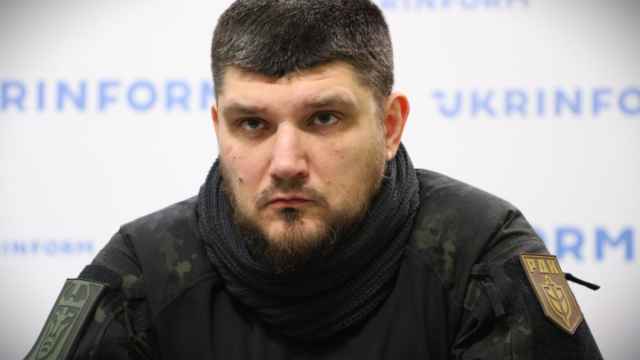ST. PETERSBURG — With St. Petersburg's Pulkovo International Airport celebrating its 90th birthday this year, and talks underway about declaring the original terminal building a historic landmark, preparations for the opening of a new terminal at the end of this year continue apace.
The airport is also continuing to develop and improve its lesser-known services, which include aviation ornithology and behavioral profiling.
In addition to the expected airport security measures that Pulkovo follows, the airport also practices aviation ornithology. The work of its ornithology service involves the management and elimination of various factors that contribute to the gathering of birds at the airport, a phenomenon that presents a real danger for aircraft landing and taking off.
Pulkovo's ornithology station, probably the airport's most unusual service, is located in a separate building on the periphery of the facility. The first thing one sees when approaching the building is a number of falcons sitting in a row on a log, enjoying the fresh air.
Winged Workers
The falcons are genuine airport "employees," trained to frighten off the numerous other birds that approach the runway and risk colliding with aircraft or being sucked into their engines.
"Other birds are afraid of falcons," said Valery Nezdaiminov, an ornithology safety engineer.
"What's interesting is that birds are not afraid of the noise the plane engines make but are terrified when they see a falcon. By the way, the higher a falcon is, the more scared other birds get," Nezdaiminov said.
Nezdaiminov and his colleagues regularly train falcons for their job, and after each flight the falcons return to their trainers.
Sergei Lobanov, one of the engineers with the aviation ornithology group, said that while for many airports birds do not pose a threat, St. Petersburg is one of those airports at which they represent a serious hazard.
"The problem is that this area of St. Petersburg was historically a place where migrating birds landed to rest. Therefore, they are still attracted here, especially during spring and fall migration. That is why our service is essential for the airport," Lobanov said.
"The service was founded in the 1980s when a new generation of jet planes appeared on the market. They flew faster and birds had difficulties flying away from them as quickly," he said.
Meanwhile, falcons are not the only means employed to scare away random birds. The aviation ornithologists also use special flares.
"What's interesting is that different birds have different reactions to such measures. For instance, crows perceive the danger quickly and fly away, while seagulls are a bit duller. In fact, we use the falcons when birds do not react to our use of mechanical devices," Lobanov said.
Nezdaiminov said the ornithology service has five working falcons and two involved in breeding.
"It's always better to have [our] own nestlings to rear and train from a very early age," Nezdaiminov said.
Meanwhile, to further strengthen Pulkovo's ornithological security, the airport is also pursuing a policy of cutting trees and draining swampy areas, as well as erecting fences with flags that also scare the birds away. It has also equipped and modernized the airport's runways with video cameras and a modern bioacoustics system, which monitors the area and is capable of emitting sounds targeted at scaring off birds in any given sector.
Profiling
In response to the increasing frequency of terrorist attacks both in Russia and the rest of the world, in 2008 Pulkovo's security inspection service introduced a special unit of behavioral profilers, employees involved in "the identification of potentially dangerous persons."
The first such service was introduced by Israeli air company El Al Airlines, said Natalya Borovikova, a psychologist working at the airport who created the profiling strategy at the Pulkovo Security Inspection Service. "The Israeli experience proved to be effective, and we decided to implement it," Borovikova said.
The method of profiling is based both on technical means of identification and knowledge of human psychology.
"The identification of a person's security status begins as soon as he or she enters the airport terminal. When people pass through baggage inspection, they are already under close scrutiny by the security staff, who observe people's behavior, appearance, luggage and other characteristics," Borovikova said.
Making jokes about being in possession of a bomb or other means of carrying out a terrorist act is completely inappropriate while passing through security checks, Borovikova said.
"People must understand that any jokes of this kind put them at serious risk of being barred from boarding their flight because security personnel are obliged to respond to such statements with all seriousness," she said.
Borovikova said that when a young man accompanying his mother, who was in a wheelchair, joked that his belt bag was a suicide bomber's belt, he was prohibited from flying and caused serious inconvenience for his handicapped mother.
If any passengers seem suspicious or anxious, security inspection personnel will engage them in an effort to deduce their intentions and mood. These interviews conclude with one of four results. If suspicions arise, the agent may request a member of the airport's police unit to investigate the person further. More serious suspicions will lead profilers to recommend that the airline refuse to let the passenger fly.
According to Borovikova, the profilers are highly trained security agents. They have to undergo psychological testing to see how fit they are for the job, as well as special training to develop their skills.
"People doing profiling have to be able to observe, to communicate, to sustain concentration, to analyze and to make decisions," said Borovikova, who also pointed out that intuition is essential.
"Profilers may also approach a person with no baggage buying a ticket. Sometimes there may be nothing obviously suspicious about a person, but something in the passenger's behavior may attract the profilers' attention. In fact, any passenger can be questioned by a profiler, even if the passenger is not acting suspiciously."
Fortunately no terrorists have been discovered at the Pulkovo terminals, but the security services have annually banned about 70 people from flights on the recommendation of profilers.
Modern technologies also assist security services in the identification of potential dangers. Four years ago, Pulkovo introduced a new system of biometric video monitoring. This system is capable of detecting suspicious behavior by passengers at the airport by analyzing a person's biomechanical movements to calculate their physiological and emotional state. Using standard digital web or television cameras and image processing, the system registers and analyzes a person's movements. The micro movements made by the human head in particular are linked to something called the vestibulo-emotional reflex, which indicates a person's emotional state.
In just one minute, the system produces a profile that gauges the person's emotional state according to 10 different markers, and assigns a color code to the person being screened.
People who are assigned red or violet markings by the system are then subjected to closer scrutiny by security personnel. The color red indicates signs of aggression, while violet indicates the possible presence in the body of psychotropic substances or other drugs.
Emergency Services
The airport's emergency service has a staff of 158, with 138 of them qualified to take part in emergency situations. On each shift there are at least 31 people on duty, said Vladimir Mamayev, deputy head of Pulkovo's emergency situations department.
"We also have a certain amount of emergency equipment and machines meant to work with different kinds of airplanes," Mamayev said.
According to Mamayev, emergency situations involving planes may arise at any time, whether during refueling, taxiing, taking off or landing. The emergency staff and its equipment must be prepared for all such situations, Mamayev said.
Fortunately, no serious emergencies have occurred at Pulkovo during the past decade. The most recent situation took place in 1996, when a Tu-134 plane clipped the runway with its wing while landing. An emergency observer who worked in one of the airport's control towers saw the sparks and alerted the emergency services, Mamayev said.
"I must say the emergency crew were very fast. They managed to quickly cool the wing and began the evacuation of passengers via the inflatable escape chute," he said.
According to emergency response guidelines, the first response vehicle should arrive at the site of the emergency within three minutes, while the rest of the emergency vehicles are to be there within the next minute.
The emergency staff keeps in good shape by working out every day.
All Types Of Assistance
In 2011, Pulkovo introduced a new service meant to aid the disabled to use the airport. Currently, the service has a staff of 12 people, whose task is to help passengers with serious health problems or with limited mobility, among others.
The staff is made up exclusively of young men who speak English and are able to handle both physical exertion and psychological stress. It is vital that as well as being empathetic, they are able to remain calm in any situation.
Passengers can request assistance on Pulkovo's website, by telephone or while booking their ticket.
Alexander Babayev, one of the service's employees, said they assist 10 to 15 people with physical difficulties daily.
Babayev confirmed that service personnel need to be resistant to stress and know English.
"For instance, once we had a case when an elderly woman from Australia refused to leave the plane upon arrival in St. Petersburg, from where she was to embark on a cruise. The woman decided that she was still in Australia. So it took us quite a lot of patience to convince her she was in St. Petersburg and arrange her affairs," Babayev said.
Meanwhile, Sergei Polyakov, a doctor with the medical service at Pulkovo, said their two major tasks were to provide medical assistance to passengers and employees, and to maintain emergency and first-aid equipment in case a dangerous situation arises.
"We always have to be on alert in case of emergency," Polyakov said, showing an array of medical packages, each meant to provide aid to at least 10 people.
"In fact, passengers may indeed need help in the airport. It may have to do with strokes, heart attacks, severe pain and other problems. Sometimes people feel bad on board the plane, and we provide medical care upon their arrival," Polyakov said.
Testing The New Terminal
Before the new Pulkovo terminal hosts its first passengers in late 2013, the terminal is to be operationally tested by trial passengers.
For that purpose, operating consortium Northern Capital Gateway has formed and created a special project called Operational Readiness and Airport Transfer.
ORAT, whose practices are in line with similar testing procedures all over the world, is to assess how comfortable potential passengers will feel in the new terminal, how fast they will be able to find their way to check-in, passport control or to the departure gates, said Volker Wendefeuer, chief operating officer of Northern Capital Gateway.
ORAT is also responsible for training the airport personnel for the new facilities. The new terminal is to be equipped with an automatic baggage system and four sets of X-ray machines, and the number of check-in desks will increase from the current 40 to 88. The number of passport control desks will also increase, from 36 to 102, Volker said.
Panos Alevras, ORAT project manager in St. Petersburg, said that to adequately test the new terminal, they need to attract a couple of thousand people to perform the role of potential passengers. Those people need to be of both genders, different ages and different backgrounds.
"We'll need to involve in the operational trial people who speak only Russian, those who speak Russian and English, as well as those who speak neither English nor Russian, to see how those people will find their way through the new airport facilities," Alevras said.
ORAT expects the testing to last three months, probably until the end of summer.
"During that time, we'll test for whatever may go wrong, be it a partial or complete shutdown of electricity or any other problem," Alevras said.
Alevras also said the help of a human resource agency would probably be needed to find the trial passengers. The services of those trial passengers cannot be used more than twice during the trials to eliminate the chance that they become acquainted with the new terminal and the rest of the facilities. Meanwhile, the transfer of the airport's major services from the old terminals to the new building is to take place over the period of one night, and they are working to ensure that this event is well orchestrated, the ORAT experts said.
Contact the author at [email protected]
A Message from The Moscow Times:
Dear readers,
We are facing unprecedented challenges. Russia's Prosecutor General's Office has designated The Moscow Times as an "undesirable" organization, criminalizing our work and putting our staff at risk of prosecution. This follows our earlier unjust labeling as a "foreign agent."
These actions are direct attempts to silence independent journalism in Russia. The authorities claim our work "discredits the decisions of the Russian leadership." We see things differently: we strive to provide accurate, unbiased reporting on Russia.
We, the journalists of The Moscow Times, refuse to be silenced. But to continue our work, we need your help.
Your support, no matter how small, makes a world of difference. If you can, please support us monthly starting from just $2. It's quick to set up, and every contribution makes a significant impact.
By supporting The Moscow Times, you're defending open, independent journalism in the face of repression. Thank you for standing with us.
Remind me later.






